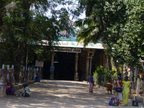
A typical feature of the numerous Vishnu temples in Tamil Nadu, is a separate sannidhi for Sudarsana Chakra, popularly known in the south as Chakrathalvaar.
The Sudarshana Sannidhi of the Ranganatha temple of Srirangam ( shown in the accompanying photo on the left) is particularly well known. Among the well known Vishnu shrines is Kumbakonam, hailed as the town of temples, is the temple of Chakrapani. This is the only temple where the principal deity is Sri Sudarsana (Chakrapani) with an awe-inspiring third eye on his forehead and four hands holding various weapons. Legend has it that Lord Vishnu once dispatched the trusted Sri Sudarsana to destroy the demon Jalandasura in paatal lok (netherworld).
After executing the assigned task, Sri Sudarsana emerged from below the earth at Kumbakonam on the banks of the Kaveri river and reached Brahma who was then bathing there. Brahma consecrated the image of Sri Sudarsana in this place and worshipped Him. This spot is called Chakratirtham. It is believed that Lord Sarafoji Maharaja, the Maratha king who ruled Tanjavur installed his and his daughter’s bronze statues in the temple to mark the curing of his daughter’s illness, through the grace of Chakrapani.
The Panchayudha stotra is about Lord Vishnu’s 5 weapons (Shankh, Chakra, Gadha, Khadga and Saranga). Of these the Chakram commands primacy and is the King of Weapons (Heti Raja). The following verse from this stotram describes the attributes of the powerful Sudarsana Chakra.
In the Vishnu Sahasarnamam, the mighty Chakra figures in the important, concluding verse:
Adorning the right hand of Vishnu, Sudarsana is the most potent of all the weapons of Sri Narayana. There are several instances when Chakrayudha was used to destroy evil forces. When Rahu and Ketu cheated the Devas by joining the queue during the distribution of amrit, Maha Vishnu severed their heads using Sudarsana. Again, in the Mahabharata, when Sishupala crossed all limits and abused Krsna more than a 100 times during Draupadi’s Swayamvara, Krsna killed him using Sudarsana Chakra.
Sudarsana also came to the rescue of Vishnu’s devotees like Gajendra whenever they faced danger. King Ambarish, a great Vishnu bhakta, was saved from the wrath of Durvasa who had to bow before Sudarsana and seek his pardon for being unfair to Ambarish. During the course of a fierce battle with demon Kalanemi, Vishnu ordered Sudarsana to destroy the rakshasha. After accomplishing his task, Sudarsana took a dip in the holy pond to pacify Himself. This pond is now known as Tirumukkulam near the town of Srivilliputhur.
According to the Vedas, Puranas and Itihaas, the task of protecting the good and eliminating the evil is performed by Sudarsana. The Sudarsanashtakam composed by Swami Vedanta Desika (1269-1370) brings out the magnificent characteristics of the Sudarsana Chakra in all its resplendent glory. It is sung in the 'dhrithas' chandas (metre) which is light and friendly, making this brief song a pleasure to listen to.
O Sri Sudarsana! All the enemies of your Lord's devotees run away fearing your strength. All auspicious attributes find their home in you. Those who worship you cross the 'shore less' ocean of Samsara and free themselves from the cycle of birth and death. The entire Universe is stabilized by your mighty power. You cut asunder all the sins of those who approach you as their refuge. You bless all of your devotees with the knowledge of righteous conduct as prescribed by the Vedas. O Lord Sudarsana. Hail to Thee! Hail to Thee!
The last line Jai Jai Sri Sudarsana, Jai Jai Sri Sudarsana recurs as the closing line of each of the eight paras of the Ashtakam. It is believed that the shloka was composed by Sri Desika to invoke the blessings of Sudarsana to alleviate the sufferings of the residents of Tiruputkuzhi (near Kanchivaram) who were inflicted by a dreadful disease.
In the phalastuti of the shloka - it has been said that Sri Sudarsana will take care of all the wishes of those who chant it, no matter how difficult to attain those wishes might be.
Today, devotees also seek Sri Sudarsana’s blessings by performing an Agni homam. The foremost attribute of the Sudarsana Chakram is "Pida Pradanam", or relief from all kinds of pain and suffering. The Chakram also has the attribute of "Papa Nashanam" destroying one's sins.
Therefore, performance of the Sudarsana Homam confers health, wealth and prosperity on the seeker (in this case the person who performs the Homam). Purity of thought, sound and intonation while chanting the Homa mantras is vital for attaining sampurna phalam.
No comments:
Post a Comment